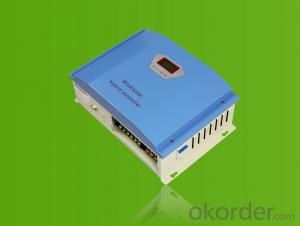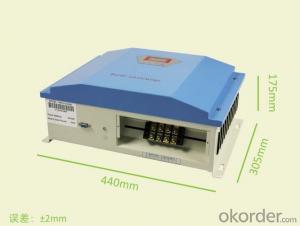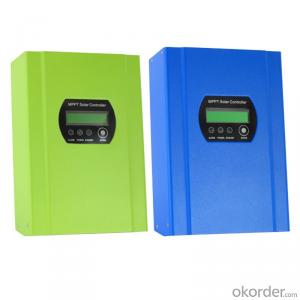Solar Controllers Brisbane - MPPT Solar Charge Controller 30A, 12/24V/48V Automatic Recognition, 15A~40A
- Loading Port:
- China main port
- Payment Terms:
- TT OR LC
- Min Order Qty:
- 20 unit
- Supply Capability:
- 9999 unit/month
OKorder Service Pledge
OKorder Financial Service
You Might Also Like
Home system MPPT solar panel charge controller with remote control 15A 25A 30A 40A

| Introduction |
This e-SMART MPPT (maximum Power Point Tracking) solar charge controller is a smart solar controller with automatic recognition function, smart charging and discharging function, three stages charging function to protect battery. It can increase 30%~60% efficiency than traditional PWM controller. It supports many kinds of batteries.It also have RS232 communication function.
| Product Show |


| Features |
1. MPPT charging mode, peak efficiency up to 99%, saving 30%~60% solar panel than traditional PWM controller.
2. DC12V/24V/48V battery system automatic recognition, users can use it in different system conveniently.
3. Maximum PV input voltage up to DC100V.
4. Three stages charge: fast charge(MPPT), constant voltage charge,floating charge, It can protect batteries well .
5. Three option of discharge: on mode and off mode and PV voltage(solar) control mode.
6. Users can choose 4 kinds of commonly standard batteries(Sealed lead acid, Vented, Gel, NiCd). Other kinds of batteries can be defined by users.
7. Digital tube can display battery voltage and charging current. The software can display various parameters such as model number, PV input voltage, battery type, battery voltage, charging current, charging power, working condition.
8. RS232 communication, we can offer communication protocol also, it’s convenient for user’s integration management.
9. This controller can be paralleled infinitely.
10. CE and RoHS Certifications are approved.We can help clients to approve other certifications.
11. 2 years warranty; 3~10 years extended technical service.
| Application |

| Parameter |
MPPT solar controller modes:I-P-e-SMART-12V/24V/48V-series | 15A | 20A | 25A | 30A | 40A | |
Charge mode | MPPT(maximum power point tracking) | |||||
Charge method | Three stages: constant current(MPPT),constant voltage,floating charge | |||||
System type | DC12V/24V/48V | Automatic recognition | ||||
System voltage | 12V system | DC9V~DC15V | ||||
24V system | DC18V~DC30V | |||||
48V system | DC36V~DC60V | |||||
Soft start time | 12V/24V/48V system | ≤3S | ||||
Dynamic response recovery time | 12V/24V/48V system | 500us | ||||
MPPT efficiency | 12V/24V/48V system | ≥96.5%,≤99% | ||||
INPUT CHARACTERISTICS | ||||||
MPPT working voltage range | 12V system | DC14V~DC100V | ||||
24V system | DC30~DC100V | |||||
48V system | DC60~DC100V | |||||
Low input voltage protection point | 12V system | DC14V | ||||
24V system | DC30V | |||||
48V system | DC60V | |||||
Low input voltage Recovery point | 12V system | DC18V | ||||
24V system | DC34V | |||||
48V system | DC65V | |||||
High input voltage protection point | 12V/24V/48V system | DC110 | ||||
High input voltage recovery point | 12V/24V/48V system | DC100V | ||||
Maximum PV power | 12V system (W) | 213 | 284 | 355 | 426 | 568 |
24V system (W) | 426 | 568 | 710 | 852 | 1136 | |
48V system (W) | 852 | 1136 | 1420 | 1704 | 2272 | |
CHARGE CHRECTRESTICS | ||||||
Selectable Battery Types (Default Gel battery) | 12V/24V/48V system | Sealed lead acid, Vented, Gel, NiCd battery (Other types of the batteries also can be defined)) | ||||
Constant Voltage | 12V/24V/48V system | Please check the charge voltage according to the battery type form. | ||||
Floating Charge Voltage | 12V/24V/48V system | |||||
Rated Input Current | 12V/24V/48V system | 15A | 20A | 25A | 30A | 40A |
Current-limit Protection | 12V/24V/48V system | 20A | 25A | 30A | 35A | 45A |
Temperature Factor | 12V/24V/48V system | ±0.02%/℃ | ||||
Temperature Compensation | 12V/24V/48V system | 14.2V-(The highest temperature-25℃)*0.3 | ||||
Output Ripples(peak) | 12V/24V/48V system | 200mV | ||||
Output Voltage Stability Precision | 12V/24V/48V system | ≤±1.5% | ||||
The specification is only for reference. Subject to change without prior notice.
RS232 Function working stat |
The Figures of the PC Firmware and Testing Software:

We provide OEM and ODM service.The 36V/72V/96V model also can be custom made for you.
Packaging |

Certifications |

F&Q: |
Q1. How to ensure and monitor the products quality?
A1: We have established a perfect Quality Management System, In strict
accordance with ISO9001: 2008 quality system and ISO14001 environment system for quality assurance management;
Our ISO9001:2008 Quality System certificate encoding: CHIN/TW/QMS/00119;
Our ISO14001 Environment System certificate encoding: CHIN/TW/EMS/00028;
Q2. What is the warranty of products?
A2: The warranty period of different products are different; 5 years, 3 years, 2 years, 1 years; More details please refer to the product specification or manual; we will provide free life-long technical support ;
Q3. What is the difference between MPPT&PWM?
A3. MPPT charging mode, peak efficiency up to 99%, saving 30%~60% solar panel than traditional PWM controller.
- Q: What is the role of a solar controller in preventing battery freezing?
- The role of a solar controller in preventing battery freezing is to regulate the charging and discharging of the battery based on its temperature. It monitors the battery temperature and adjusts the charging voltage accordingly to prevent overcharging in cold temperatures, which can lead to freezing. By ensuring that the battery is charged at the correct voltage, the solar controller helps maintain the battery's temperature within a safe range, preventing freezing and potential damage to the battery.
- Q: Do solar controllers require a separate power source?
- Yes, solar controllers do require a separate power source. They need a power source to operate and regulate the charge from the solar panels to the batteries.
- Q: Can a solar controller be used with solar-powered indoor recreational facilities?
- Solar-powered indoor recreational facilities can make use of a solar controller. This component is essential in a solar power system as it regulates the flow of electricity from the solar panels to the batteries. Its main function is to ensure efficient charging of the batteries and prevent any potential damage caused by overcharging. When it comes to solar-powered indoor recreational facilities like indoor swimming pools, gyms, or entertainment centers, the solar controller plays a crucial role in managing the energy generated by the solar panels. It helps optimize energy usage, store excess energy in batteries, and guarantee a continuous power supply even in low or no sunlight conditions. By incorporating a solar controller, these indoor recreational facilities can significantly reduce their reliance on traditional grid electricity, resulting in lower energy costs and a promotion of sustainability. Additionally, it enables them to operate independently from the grid, enhancing their ability to withstand power outages or other disruptions. All in all, including a solar controller in a solar-powered indoor recreational facility is a wise and environmentally friendly choice that can lead to long-term savings and various environmental benefits.
- Q: Can a solar controller be used with solar panel carports?
- Yes, a solar controller can be used with solar panel carports. The solar controller helps regulate the charging of the batteries connected to the solar panels, ensuring optimal power generation and storage. This is especially important for solar panel carports as they typically have a larger array of panels and require efficient management of the energy generated.
- Q: What is the boost charging mode of a solar controller?
- The boost charging mode of a solar controller is a feature that allows for the efficient charging of the battery during periods of low sunlight or low battery voltage. It increases the charging voltage to ensure the battery reaches its optimal level of charge, maximizing the performance of the solar system.
- Q: How do I calculate the size of a solar controller for my system?
- To calculate the size of a solar controller for your system, you need to consider two main factors: the maximum current capacity of your solar panels and the maximum current capacity of your battery bank. First, determine the maximum current output of your solar panels. This information is usually provided by the manufacturer. Next, determine the maximum current capacity of your battery bank. This can be calculated by dividing the battery capacity (in ampere-hours) by the desired charging time (in hours). Once you have these two values, choose a solar controller that can handle the higher of the two currents. It's recommended to choose a controller with a slightly higher current rating to allow for any future expansion of your solar panel or battery capacity.
- Q: How does a solar controller prevent overcharging?
- A solar controller prevents overcharging by regulating the amount of current and voltage going into the battery from the solar panels. It monitors the battery's state of charge and adjusts the charging process accordingly, ensuring that the battery is not subjected to excessive voltage or current that can lead to overcharging and potential damage.
- Q: Can a solar controller be used in a solar-powered emergency backup system?
- Yes, a solar controller can be used in a solar-powered emergency backup system. A solar controller is an essential component that regulates the charging and discharging of batteries in a solar system. In an emergency backup system, it helps manage the flow of power from the solar panels to the batteries, ensuring efficient charging and preventing overcharging or damage. By controlling the power flow, the solar controller helps maintain the reliability and longevity of the backup system, making it an important component in solar-powered emergency backup setups.
- Q: How does a solar controller handle the protection against overloads?
- A solar controller handles protection against overloads by monitoring the current flowing from the solar panels to the batteries. It ensures that the maximum current limit is not exceeded, preventing damage to the batteries or other connected components. This is achieved through various techniques such as pulse width modulation (PWM) or maximum power point tracking (MPPT) algorithms, which regulate the charging process and adjust the charging voltage accordingly. Additionally, some solar controllers may also have built-in overload protection mechanisms like fuses or circuit breakers to further safeguard against excessive currents.
- Q: How does a solar controller handle battery under-voltage protection?
- A solar controller handles battery under-voltage protection by monitoring the voltage of the battery connected to the solar system. If the battery voltage drops below a preset threshold, the solar controller will automatically disconnect the battery from the charging source, preventing further discharge and potential damage to the battery. This feature ensures the longevity and health of the battery while optimizing its performance.
Send your message to us
Solar Controllers Brisbane - MPPT Solar Charge Controller 30A, 12/24V/48V Automatic Recognition, 15A~40A
- Loading Port:
- China main port
- Payment Terms:
- TT OR LC
- Min Order Qty:
- 20 unit
- Supply Capability:
- 9999 unit/month
OKorder Service Pledge
OKorder Financial Service
Similar products
Hot products
Hot Searches
Related keywords




























